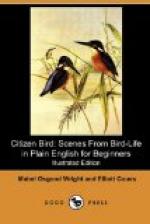“Can you always tell a Sea Duck from a River Duck by the feathers—or how?” asked Rap.
“You can always tell them by their feet,” answered the Doctor; “for every Sea Duck has a little flap of skin hanging like an apron from the hind toe, while the hind toe of every River Duck is round and slim, like a Hen’s.”
“I should think there would always be plenty of Sea Ducks,” said Rap; “for if they live so far out they ought to be able to take care of themselves and swim or fly away from everybody.”
“You would think so, my boy, but when man with his many inventions sets out to kill, there is little chance of escape for bird or beast. Sea Ducks are hunted in their nesting homes, not only for their flesh and eggs, but for the downy feathers with which the nest is lined. In their migrations overland, every hand is set against them if they pause to rest or feed.”
“But when they reach deep water, they must be safe; for they can fly faster than any boat can sail after them,” said Rap.
“Sail—yes; but men go in gunning-punts, sneak-boats, and even steam-launches, to surround the flocks of Wild Ducks that are lying low, trusting perhaps to a covering of fog, and when it lifts these water pot-hunters commit slaughter which it would be slander to call sport.”
“Oh, look!” cried Rap, “there are hundreds of Gulls over there, and Sea Swallows too. There is the island, for the breeze has come up and we have sailed ever so far without noticing it. There is a great flock of Gulls going off together—are they beginning their fall journey?”
“No, they are only going to some harbor to feed. They belong to a guild of water birds that I think we might call Sea Sweepers; for they clear from the surface of the water the refuse that the tide would otherwise throw upon the beaches. They also follow in the wake of ships for the same purpose. Neither Gulls nor Terns can dive far under water like Ducks, for their bodies are too light; but they all pounce down on wing and contrive to catch small fish swimming just below the surface.
“Look at the difference between the flight of the two! The Tern half folds his long pointed wings, and darts down like lightning; in a second he is up in the air again dashing off with capricious flight, holding his beak to his breast as the Woodcock does. But the Gull sails more slowly, settles deliberately, and often floats quietly on the surface; then when he rises on wing, with some ceremony, he flaps off with his beak held straight before him, like a Duck. Terns are the better flyers, but Gulls are decidedly the more expert swimmers.”
“Are Gulls and Terns related?” asked Dodo.
“They both belong to one family of many members. These two that you have been watching are among the best known of all—the American Herring Gull, who lives on both lake and ocean; and the Common Tern, who mostly follows the sea-coast.”
“Heads down!” called Olaf. The boom swung round, the sail dropped, and the boat ran into the shallow water of the beach at Great Gull Island. “You haven’t given us any Duck tables, Uncle Roy,” said Dodo.




